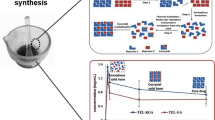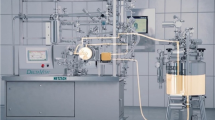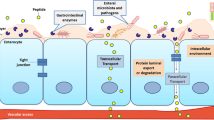Abstract
Iloperidone is a second-generation antipsychotic drug which is used for the treatment of schizophrenia and has very low aqueous solubility and bioavailability. This drug also undergoes first-pass metabolism. The aim of this work is to formulate fast-dissolving sublingual films of iloperidone to improve its bioavailability. Sublingual films were prepared by solvent casting method. Hydroxypropyl methyl cellulose E5, propylene glycol 400, and transcutol HP were optimized using Box–Behnken three-level statistical design on the basis of disintegration time and folding endurance of films. Iloperidone:hydroxypropyl-β–cyclodextrin kneaded complex was used in films instead of plain drug due to its low solubility. Optimized film was further evaluated for drug content, pH, dissolution studies, ex vivo permeation studies, and pharmacokinetic studies in rats. The optimized film disintegrated within 30 s. The in vitro dissolution of the film showed 80.3 ± 3.4% drug dissolved within first 5 min. In ex vivo permeation studies using sublingual tissue, flux achieved within first 15 min by film was around 117.1 ± 0.35 (mcg/cm2/h) which was ten times more than that of plain drug. This formulation showed excellent uniformity. AUC and Cmax of film were significantly higher (p < 0.001) as compared to plain drug and relative bioavailability of the films was 148% when compared to the plain drug. Thus, this study showed optimized fast-dissolving sublingual film to improve permeation and bioavailability of iloperidone. Fast-dissolving films will be customer-friendly approach for geadiatric schizophrenic patients.




Similar content being viewed by others
References
Jhanjee A, Bhatia MS, Rathi A. Iloperidone–a Novel Drug for treatment of schizophrenia. Delhi Psychiatry J. 2012;5(1):204–7.
Breier A, Berg PH. The psychosis of schizophrenia: prevalence, response to atypical antipsychotics, and prediction of outcome. Biol Psychiatry. 1999;46(3):361–4. https://doi.org/10.1016/S0006-3223(99)00040-2.
Cheng YH, Ilum L, Davis S. Schizophrenia and drug delivery systems. J Drug Target. 2000;8(2):107–17. https://doi.org/10.3109/10611860008996856.
Kaminsky BM, Bostwick JR, Guthrie SK. Alternate routes of administration of antidepressant and antipsychotic medications. Ann Pharmacother. 2015;49(7):808–17. https://doi.org/10.1177/1060028015583893.
Correll CU. Mechanism of action of antipsychotic medications. J Clin Psychiatry. 2014;75:347–8.
Dazzan P, Morgan KD, Orr K, et al. Different effects of typical and atypical antipsychotics on grey matter in first episode psychosis: the AESOP study. Neuropsychopharmacology. 2005;30(4):765–74. https://doi.org/10.1038/sj.npp.1300603.
Ige P, Agrawal K, Patil U. Enhanced in vitro dissolution of iloperidone using Caesalpinia Pulcherrima mucoadhesive microspheres. Beni –Univ J Basic Appl Sci. 2015;4(1):26–32. https://doi.org/10.1016/j.bjbas.2015.02.004.
Tingting Z, Yan Y, Haitao W, et al. Using dissolution and pharmacokinetics studies of crystal form to optimize the original iloperidone. Cryst Growth Des. 2013;13(12):5261–6.
Mandpe L, Pokharkar V. Targeted brain delivery of iloperidone nanostructured lipid carriers following intranasal administration: in vivo pharmacokinetics and brain distribution studies. J Nanopharmaceutics and Drug Delivery. 2013;1(2):212–25. https://doi.org/10.1166/jnd.2013.1019.
Siddiqui MN, Garg G, Sharma PK. A short review on-a novel approach in oral fast dissolving drug delivery system and their patents. Adv Biol Res. 2011;5(6):291–303.
Mansi M. Formulation and evaluation of fast dissolving film of lurasidone. Int J Pharm Res Bio. 2016;5(2):101–23.
Bhowmik D, Chiranjib B, Krishnakanth P, Chandira RM. Fast dissolving tablet: an overview. J Chem Pharm Res. 2009;1(1):163–77.
Puttalingaiah L, Mani T. Fast disintegrating tablets: an overview of formulation, technology and evaluation. Res J Pharm Biol Chem Sci. 2011;2(2):589–601.
Malviya R, Sharma PK. Trends in buccal film: formulation characteristics, recent studies and patents. Eur J Appl Sci. 2011;3(3):93–101.
Kannissery P, Tahir MA, Charoo NA, et al. Pharmaceutical product development: a quality by design approach. Int J Pharm Investig. 2016;6(3):129–38.
Zidan AS, Sammour OA, Hammad MA, Megrab NA, Habib MJ, Khan MA. Quality by design: understanding the formulate on variables of a cyclosporine A self-nanoemulsified drug delivery systems by Box-Behnken design and desirability function. Int J Pharm. 2007;332(1–2):55–63. https://doi.org/10.1016/j.ijpharm.2006.09.060.
Elbary AA, Aboelwafa AA, Sharabi IM. Once daily, high-dose mesalazine controlled-release tablet for colonic delivery: optimization of formulation variables using Box-Behnken design. AAPS PharmSciTech. 2011;12(4):1454–64. https://doi.org/10.1208/s12249-011-9708-9.
Basalious EB, El-Sebaie W, El-Gazayerly O. Application of pharmaceutical QbD for enhancement of the solubility and dissolution of a class II BCS drug using polymeric surfactants and crystallization inhibitors: development of controlled-release tablets. AAPS PharmSciTech. 2011;12(3):799–810.
Hoffmann EM, Breitenbach A, Breitkreutz J. Advances in orodispersible films for drug delivery. Expert Opin Drug Delivery. 2011;8(3):299–316. https://doi.org/10.1517/17425247.2011.553217.
Patil P, Shrivastava SK. Fast dissolving oral films: an innovative drug delivery system. Int J Sci Res. 2014;3(7):2088–92.
Sherje A, Londhe V. Inclusion complexes of hydroxy propyl-β-cyclodextrin and paliperidone: preparation and characterization. Curr Drug Discov Technol. 2014;11(4):271–8.
Li L, Yi T, Lam C. Effects of spray-drying and choice of solid carriers on concentrations of Labrasol® and Transcutol® in solid self-microemulsifying drug delivery systems (SMEDDS). Molecules. 2013;18(12):545–60. https://doi.org/10.3390/molecules18010545.
Kumar GP, Phani AR, Prasad RG, et al. Polyvinylpyrrolidone oral films of enrofloxacin: film characterization and drug release. Int J Pharm. 2014;471(1):146–52. https://doi.org/10.1016/j.ijpharm.2014.05.033.
Londhe VY, Umalkar KB. Formulation development and evaluation of fast dissolving film of telmisartan. Indian J Pharm Sci. 2012;74(2):122–6. https://doi.org/10.4103/0250-474X.103842.
Dixit AS, Kulkarni PK. Fast disintegrating films containing anastrozole as a dosage form for dysphagia patients. Arch Pharm Res. 2012;35(12):2171–82.
Visser JC, Dohmen WM, Hinrichs WL, et al. Quality by design approach for optimizing the formulation and physical properties of extemporaneously prepared orodispersible films. Int J Pharm. 2015;485(1):70–6. https://doi.org/10.1016/j.ijpharm.2015.03.005.
Sayed S, Howida K, Magdy Ibrahim M, Mohamed F. Fast-dissolving sublingual films of terbutaline sulfate: formulation and in vitro/in vivo evaluation. Mol Pharm. 2013;10(8):2942–7. https://doi.org/10.1021/mp4000713.
Rachid O, Mutasem R, Estelle R, Keith J. Rapidly-disintegrating sublingual tablets of epinephrine: role of non-medicinal ingredients in formulation development. Eur J Pharm Biopharm. 2012;82(3):598–604. https://doi.org/10.1016/j.ejpb.2012.05.020.
Chonkar A, Rao V, Srinivas M, et al. Development of fast dissolving oral films containing lercanidipine HCl nanoparticles in semicrystalline polymeric matrix for enhanced dissolution and ex vivo permeation. Eur J Pharm Biopharm. 2016;103:179–91.
Tomar A, Sharma K, Chauhan NS, et al. Formulation and evaluation of fast dissolving oral film of dicyclomine as potential route of buccal delivery. Int J Drug Dev Res. 2012;4(2):408–17.
Mesnukul A, Yodkhum K, Phaechamud T. Solid dispersion matrix tablet comprising indomethacin-PEG-HPMC fabricated with fusion and mold technique. Indian J Pharm Sci. 2009;71(4):413–20. https://doi.org/10.4103/0250-474X.57290.
Wu L, Qiao Y, Wang L, Guo J, Wang G, He W, et al. A self-microemulsifying drug delivery system (SMEDDS) for a novel medicative compound against depression: a preparation and bioavailability study in rats. AAPS PharmSciTech. 2015;16(5):1051–8. https://doi.org/10.1208/s12249-014-0280-y.
Mihajlovic T, Kachrimanis K, Graovac A, et al. Improvement of aripiprazole solubility by complexation with (2-hydroxy) propyl-β-cyclodextrin using spray drying technique. AAPS PharmSciTech. 2012;13(2):623–31.
Mura P, Faucci MT, Bramanti G, Corti P. Evaluation of transcutol as a clonazepam transdermal permeation enhancer from hydrophilic gel formulations. Eur J Pharm Biopharm. 2000;9(4):365–72.
Gannu R, Vishnu YV, Kishan V, Rao YM. In vitro permeation of carvedilol through porcine skin: effect of vehicles and penetration enhancers. PDA J Pharm Sci Technol. 2008;62(4):256–63.
Rathi AA, Dhamecha DL, Patel KA, et al. Effect of permeation enhancers on permeation kinetics of idebenone through the bovine buccal mucosa. Ind J Pharm Edu Res. 2011;45(4):370–4.
Ahmed ED, Basalious EB, Abdelmalak NS. Bioenhanced sublingual tablet of drug with limited permeability using novel surfactant binder and microencapsulated polysorbate: in vitro/in vivo evaluation. Eur J Pharm Biopharm. 2015;94:386–92.
Acknowledgements
Authors would like to thank Lupin Ltd. for providing iloperidone gift sample and Gattefosse for providing transcutol HP gift sample. We would like to also thank Mr. Ankit Laddha, research scholar, SPPSPTM for helping in pharmacokinetic studies.
Author information
Authors and Affiliations
Corresponding author
Ethics declarations
Conflict of Interest
The authors declare that they have no conflict of interest.
Electronic supplementary material
ESM 1
(DOCX 608 kb)
Rights and permissions
About this article
Cite this article
Londhe, V., Shirsat, R. Formulation and Characterization of Fast-Dissolving Sublingual Film of Iloperidone Using Box–Behnken Design for Enhancement of Oral Bioavailability. AAPS PharmSciTech 19, 1392–1400 (2018). https://doi.org/10.1208/s12249-018-0954-y
Received:
Accepted:
Published:
Issue Date:
DOI: https://doi.org/10.1208/s12249-018-0954-y




